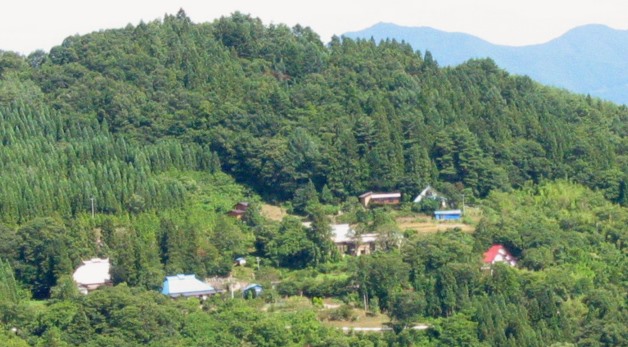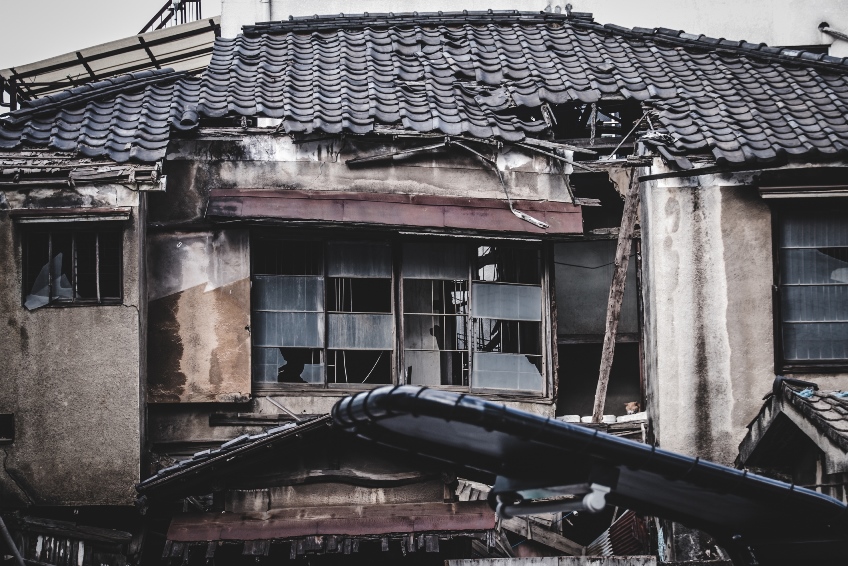- Article
- Abandoned Land
Land Issues in the Era of Depopulation: An Interview with Author Shoko Yoshihara
August 8, 2017

Research fellow Shoko Yoshihara shares her insights into the escalating problem of abandoned and unclaimed land, the subject of her groundbreaking research and recently published book.
* * *
——Your new book, Jinko gensho jidai no tochi mondai [Land Issues in the Era of Depopulation], came out on July 20. Can you tell us how you became interested in land issues ?

SHOKO YOSHIHARA: The book is an outgrowth of the research conducted for the Tokyo Foundation project on the Conservation of Land Resources, beginning in 2009. Dr. Yoshinori Yasuda, then a senior research fellow at the Foundation, called attention to the problem of abandoned forestland in rural regions where the population was aging and dwindling, raising concerns about the fate of watershed forests that were vital to the local environment and the conservation of groundwater resources. I began working on those issues out of a shared sense of alarm.
In the beginning, our work was centered on what was above and below the forest floor. But the more we studied the issue, the more we realized that the fundamental problem lay with Japanese laws and systems governing the land itself. So we gradually shifted our focus.
——You use the term shoyusha fumei, or “owner unknown,” to refer to the problem of abandoned land with no clear title. Is that different from the problem of absentee landowners?
YOSHIHARA: Absentee landowners are simply owners who live elsewhere; we know who they are. The problem we’re addressing is the situation where we can’t track the owners down. This is a phenomenon that existed well before we began our project, but it didn’t have a name. It was then senior fellow Hideki Hirano who came up with the term shoyusha fumei , and it’s now fairly frequently used in administrative documents and media reports. Not everyone uses it in exactly the same sense, though. We use it to refer to situations in which you can’t immediately identify or locate a living owner even with the help of information in the public registers. This is a problem that time will not solve. It’ll only get worse, as memories fade and information becomes outdated.
—— How is it that this situation came about?
YOSHIHARA: One factor has been the shortcomings in our land laws and registration systems. This was not much of a problem in the past, when we had close-knit rural communities, and people recognized land as an asset. People knew who owned what, even if public records were missing or incomplete. But when the population began to decline, with owners and heirs moving to the city, and property prices plummeted, people began losing not only interest in the land but also their awareness of ownership. Once information is lost from both the community’s collective memory and the public records, you have a situation of unknown landowners.
The reason the public records are incomplete or missing is that the basic source of information on land ownership is the real property registry, which is a voluntary system. It’s up to the owner to decide whether or not to register the property. The system was set up to protect people’s property rights and make land transactions safer, not to provide local governments with information on the ownership of land under their jurisdiction.
When real estate prices were high and land was changing hands constantly, owners figured it was worth the trouble and expense to protect their title by registering it. But nowadays, when the pace of land transactions is much slower, people who inherit a parcel of land—especially in a rural area—are much less motivated to expend the time and money involved in transferring the title. So, a major factor behind this phenomenon of missing landowners is the fact that the law doesn’t require land records to be kept up-to-date.
This emerged as a serious issue after the Tohoku tsunami, when local authorities were unable to track down the owners of elevated land to rebuild decimated communities along the coast. But it’s also creating problems in urban areas, where authorities can’t identify the owners of dilapidated, abandoned homes. So there is growing awareness of the shortcomings of the current land registration system.
——You’ve done a lot of work quantifying this problem as well, surveying all the 1,718 municipalities around the country plus Tokyo ’s 23 wards. Can you talk about the findings of that survey?
YOSHIHARA: We received valid responses from 888 local governments—a response rate of 52 percent—which was considerably higher than we had anticipated. And many of the respondents provided detailed write-in responses, which helped to illuminate the magnitude of the problems facing local authorities. When the heirs of a deceased landowner fail to register the transfer of title, for instance, local tax authorities have no choice but to continue levying taxes on the deceased. A full 87 percent of respondents thought that this phenomenon was likely to become more prevalent in the future.
Many explained the trend in minute detail, noting that heirs had no legal obligation to register the transfer of title and that people saw no point in going to the trouble if it was just going to saddle them with additional maintenance costs and real-estate taxes. Often the heirs expressed a wish to relinquish their rights. So, here we see a disconnect between the existing system and the way people feel about the land. With property values falling everywhere but in the cities, land that has no real market value is being abandoned, and local administrators have no means of dealing with the problem.
—— What should be done to coordinate the viewpoints of various stakeholders to address this issue?
YOSHIHARA: The problem is actually built into our legal system but has become visible only recently as depopulation and demographic aging have accelerated. There’s no magic bullet. It’s an issue that won’t go away simply by making title registration mandatory.
I think we need to look at it in terms of three basic policy challenges. The first is how to get people to register title transfers when they inherit real estate. The second is how to protect and manage land that has no immediate prospects for use so that it can be preserved for future generations. And the third is improving our data collection and management infrastructure.
Let’s begin with the registration of inherited property. We have to do our best to prevent the problem from escalating by adopting measures to encourage registration. Ultimately, the entire system needs to be revamped, but that’s no easy matter, since that would require revisions to the Civil Code. The best way to encourage registration within the framework of the current system is to make it easier and cheaper. Ultimately a legal workaround is going to be necessary to secure land of unknown ownership for public works projects; the central government has begun studying the possibility of giving local authorities usage rights to such land without transferring the title, and I think such legal reforms will probably be necessary at some point.

Next, there’s the issue of who will look after unwanted land. The thing that shocked me the most during my research was being told by a local government official that unclaimed land, with no one to look after it, was like an unwanted child. He told me that an elderly couple had come to donate their unused land because the property taxes were a burden but that he had to refuse the offer, saying that the local government couldn’t accept property in the absence of any plans to use it for public purposes. This is generally the stance of the central government as well.
Any inherited land that people don’t want to claim usually has no market value and can’t be sold, so heirs have the least to lose by leaving it unregistered. In the case of abandoned homes, the problem is more visible, as a property becomes dilapidated. This points to the fact that along with ownership, people are also abandoning their maintenance responsibilities. To discourage both types of abandonment, we need to offer multiple options for legally disposing of inherited land while it still has some utility, either through donation or consignment to a nonprofit group for management. One model is the system of land banking in the United States.
As for data collection and maintenance, the fact that title registration isn’t mandatory under existing laws means that we can’t fully depend on the real property registry for information on current ownership. So, what can we do to secure that information? Some experts have proposed adding a real property registration function to the My Number taxpayer ID system. We need to start thinking about leveraging new technologies to keep track of ownership data even after people migrate to the city or, for that matter, move overseas.
——Lastly, what can ordinary citizens do to mitigate this problem?
YOSHIHARA: I think it’s important for each of us to gain a better understanding of the problem, since it basically boils down to what individual owners do or don’t do. People might feel that what they do with their inheritance is their own private affair, but their decisions about registering and maintaining inherited land can have broad repercussions; that forgotten plot of land back home, for example, could end up stymieing reconstruction efforts following a natural disaster. People might not make that connection now, but there’s a need to nurture such awareness.
There are so few chances for ordinary citizens to learn about land laws in Japan. I think it’s important that we take every opportunity to bring these issues to the public’s attention.
Japan’s Other Land Problem
Undefined Boundaries in Urban Areas
(SIDELIGHT)
Residential land in and around big cities like Tokyo is much less likely to go unclaimed than farmland and forestland. High property values create a strong incentive for individuals to register inherited land and meet their responsibilities as owners. But the cities and suburbs face a land dilemma of their own: a lack of cadastral data that could prove crippling in the aftermath of a major disaster.
The Japanese government launched a national cadastral survey in 1951 with the goal of mapping and registering all the land in Japan. Each municipality is responsible for surveying the land under its jurisdiction and recording the boundaries and owners of each parcel, with the exception of national forests and publicly owned bodies of water. Unfortunately, as of the end of fiscal 2016, the survey was only 52% complete, according to the Ministry of Land, Infrastructure, Transport, and Tourism.
MLIT reports that cadastral surveying has been completed on 73% of Japan’s farmland, 54% of its residential land, and 45% of its forestland. In Japan’s most heavily populated urban areas, the overall rate of completion is just 24%. In Kyoto Prefecture, the survey is not even 10% complete; in Osaka, Aichi, Kanagawa, and Chiba Prefectures, between 10% and 20% of the land has been surveyed. In Tokyo Metropolis, the figure is 23%.
Why has progress been so slow? Some municipalities find it hard to secure the necessary funding and personnel. But another important factor is local authorities’ reluctance to stir up property disputes between neighbors. Many would prefer to “let sleeping dogs lie.”
The absence of cadastral boundaries does not ordinarily prevent people from buying and selling land. Typically, the seller will pay a surveyor to calculate the area within the apparent boundaries of the lot, and a contract will be drawn up accordingly. However, when local authorities are negotiating the acquisition of land for major projects, whether for community redevelopment or post-disaster reconstruction, they need to confirm the exact boundaries and dimensions of the land to be acquired with each of the landowners and other stakeholders. In such cases, the lack of clear legal boundaries can seriously impede progress.
This was the case in the town of Otsuchi in Iwate Prefecture, one of the communities hardest hit by the 2011 Tohoku tsunami. Because the cadastral survey was not complete at the time of the disaster, local authorities have spent almost four years conducting preliminary surveys of sites for the relocation of residential neighborhoods to higher ground. The densely populated Tokyo and Osaka regions are also at risk from major earthquakes and tsunami. One shudders to imagine the kind of red tape that could ensnarl reconstruction efforts in these largely unsurveyed urban areas.
(Interview conducted by the Tokyo Foundation public communications department on July 11, 2017. The original article in Japanese can be read here: https://www.tkfd.or.jp/research/detail.php?id=261. Sidelight translated from "Toshibu no mo hitotsu no tochi risuku," Ekonomisuto , August 22, 2017. Courtesy of the Mainichi Newspapers.)

